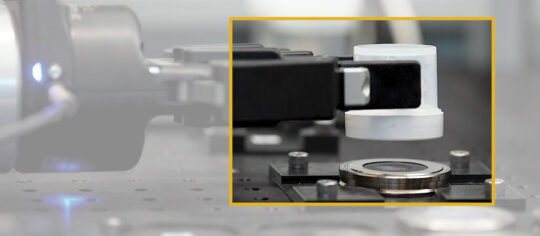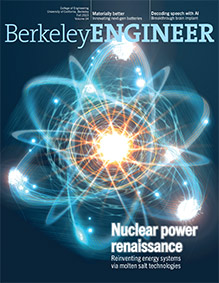 Professor Gerbrand Ceder inside Berkeley Lab’s fully automated A-Lab, which uses AI and robotics to synthesize new materials 24/7 without human intervention. (Photo by Adam Lau/Berkeley Engineering)
Professor Gerbrand Ceder inside Berkeley Lab’s fully automated A-Lab, which uses AI and robotics to synthesize new materials 24/7 without human intervention. (Photo by Adam Lau/Berkeley Engineering)Materially better
For Gerbrand Ceder, professor of materials science and engineering and senior faculty scientist at Berkeley Lab, time is of the essence. A leader in energy storage research, he brings urgency to his life’s work in developing the essential materials for a battery-powered future.
“My whole career, I’ve always been guided by trying to do things more rapidly,” he says. “If we’re going to solve the different problems we’re facing in the energy transition, we have to do this research faster.”
Over decades of investigation, this push for swift results has brought forth critical technologies that make batteries more efficient, sustainable and safe. In the 1990s, his work led to more rapid charging for lithium-ion batteries. In the early 2000s, he brought quantum mechanics research to materials development, ushering in advances in machine learning. The next decade, Ceder and his team found less expensive, high-energy lithium alternatives to lithium-ion batteries.
Today, his research is, quite literally, entering a new space: a lab that automates synthesizing materials that have been designed computationally, dramatically speeding up a typically slow and laborious process. The lab is developing new energy storage materials two orders of magnitude faster than had been achieved previously and allows researchers to evaluate small variations in materials, processing conditions and precursor chemicals.
According to Ceder, not only is this a potential game-changer for battery research, but this new approach may mark the biggest innovation in materials research in the last 70 years. The lab, he says, “is a beta-test for a new way of doing science by using automation, artificial intelligence and machine learning to the fullest extent to accelerate the pace at which science can be done.”
High-throughput computing
In the late 1990s, Ceder’s group was one of the first to apply what was then called “first-principles modeling” to battery materials. The approach had been used in physics research, but Ceder, then at MIT, wanted to use it to solve technologically relevant problems. He picked lithium-ion battery materials, then a relatively new technology that had been commercially available for less than a decade. It was a lucky choice. His group moved the field forward through discoveries on lithium-ion battery fundamentals, including the diffusion mechanisms for lithium ions through cathodes.

(Photo by Berkeley Lab)
That discovery led to Ceder’s group designing and demonstrating the highest rate of lithium-ion transport then seen, enabling faster battery recharging. “There was some skepticism around that at the time, but it has really withstood the test of time,” says Mark Asta, professor of materials science and engineering.
Materials science research has long focused on developing new materials with properties fit for specific uses. In the late 1990s, researchers were performing computations to understand these properties material by material. Ceder had another idea.
“If you can compute something once, why not 10,000 times?” he says. The result was high-throughput computing: the automated characterization at the atomic and subatomic levels of known and new materials and their properties. Teamed with data mining, it continues to power research in battery materials in Ceder’s group. It has also had an enormous impact on materials science research more broadly.
In the early 2000s, Ceder and his team were using the technique in-house. They were contacted by the White House Office of Science and Technology Policy to turn the approach into a nationwide project. That effort, called the Materials Genome Project, helped lead to the Materials Genome Initiative in 2011, a multi-agency federal project to cut in half the time needed to get from discovery to deployment of advanced materials and to dramatically cut costs.
The Materials Project “is probably the most successful outcome on the computational side,” of the initiative, Ceder says. The project, which was founded at Berkeley Lab in the same year by Kristin Persson, professor of materials science and engineering, included Ceder’s group as one of the core partners. For over a decade, it has provided an invaluable resource to the global materials science community: open access to computed information on nearly 155,000 known and predicted materials and tools for designing new materials.
Both high-throughput computing and computer modeling for lithium-ion research had important follow-on effects. Jeff Neaton, professor of physics and the associate laboratory director for energy sciences at Berkeley Lab, says that Ceder’s calculations of lithium-ion battery materials built confidence in the experimental research community and in industry that computation could be used to accurately predict materials performance.
And high-throughput computing gave the materials science community orders of magnitude more data, Asta says. That allowed the community to generate large enough datasets to “start to understand how those tools of machine learning and AI could impact the process of materials discovery.”
Supporting sustainability
The lithium-ion batteries common in electric vehicles (EVs) and consumer electronics use cathodes made from a class of materials including nickel, manganese and cobalt. Because cobalt is expensive and mined in locations with unethical standards, many manufacturers have reduced cobalt content, replacing it with nickel. But nickel, while less scarce than cobalt, remains expensive and is also mined in countries with less than rigorous environmental standards, Ceder says.

(Photo by Berkeley Lab)
Conventional lithium-ion batteries have an orderly atomic-layered structure of cathode elements. Lithium ions move through defined pathways and line up along these layers. But in 2014, Ceder’s group found that batteries could hold more lithium with a disordered atomic cathode structure. The structure they’ve developed is called DRX for disordered rocksalts with excess lithium. More lithium stored equals more energy stored, and with DRX, nearly any metal could be used to replace nickel or cobalt. But that metal needs to be cheap and abundant.
“You’d need multiple millions of tons per year, and that starts to seriously filter what you can use,” Ceder says.
Ceder’s group picked titanium and manganese. In 2018, the Department of Energy (DOE) funded a “deep dive” for the group to study remaining issues. With these successfully resolved, the DOE then funded Berkeley Lab to lead a consortium of national labs to study technical issues for scale up, including making materials in larger quantities and modifying other battery components for compatibility. If this research is successful, industry will likely take over, says Ceder, who is co-leading the consortium with Berkeley Lab scientist Guoying Chen.
Manganese and titanium are highly abundant and very cheap — less than a dollar per kilogram — while nickel is about $25 a kilogram, and cobalt fluctuates from $30 to $60 a kilogram, Ceder says. DRX technology could therefore mean much cheaper EVs with longer ranges.
“It’s almost like you’re cutting the price of the car in half, because the cost of the battery is a very large chunk of the cost of the EV. And if you can have cheaper materials, you can make driving range go up because driving range is in large part an issue of cost,” Ceder says.
Safer and more stable
In addition to improving lithium-ion technology, Ceder is studying battery options beyond it.
One problem with lithium-ion batteries is their flammability: if a battery is punctured or overheats, the liquid electrolytes between the anode and the cathode can catch fire.
Ceder’s group is working to replace liquid electrolytes with solid ion conductors to create solid-state batteries, which would be much safer. Researchers are exploring whether lithium metal anodes in solid-state batteries give them a higher energy density profile, but Ceder cautions that’s not proven. Challenges to solid-state batteries include designing a solid material that allows for rapid transport of lithium ions and is also stable.

(Photo by Berkeley Lab)
Ceder’s been joined by chemical engineering professor Bryan McCloskey on one approach: solid-state lithium-air batteries.
Lithium air is an alternative chemistry to lithium ion that intentionally reacts lithium with oxygen. Since oxygen is a very strong oxidizing agent and lithium a strong reducing agent, in theory the combination could produce a great deal of energy. But the chemistry has been plagued by interfacial instabilities, largely due to the liquid electrolyte. Fixing these instabilities is a subject of McCloskey’s research. Replacing liquid electrolytes with solid-state ion conductors could solve the problem, McCloskey says, and that’s the goal of his and Ceder’s current research. The two are joined in the project by Mary Scott, assistant professor of materials science and engineering.
But Ceder’s work in the field is much broader than just lithium-air batteries, McCloskey notes. “He’s looking at a variety of different classes of solid-state ion conductors, using both computational and experimental methods,” he says.
Relieving the bottleneck
Ceder’s career-long goal to speed research has found further fulfillment through Berkeley’s Lab’s A-Lab. The idea for the lab came about seven years ago through brainstorming at a regular retreat Ceder’s group holds. Computational materials design had evolved well enough to allow researchers to design most of what they needed, Ceder says. But the bottleneck came in trying to actually make these materials.
“We had all these great ideas for new materials,” he says. “And then you send a student in the lab to make a completely new compound. If you’re lucky, in two weeks, they have it. If you’re not, six months later, they’re still slogging at it, and they have no signs of life.”
After tossing around ideas, robotic, machine-learning-driven synthesis was proposed. After “a lot of iteration in our minds,” construction on the lab started two years ago, Ceder says.
The result, A-Lab, has been operating since February. The lab, a set of furnaces and other equipment, robots and software, works without human involvement to synthesize new materials. It takes input commands for computer-designed compounds, then gets to work. The first five attempts are what Ceder calls “literature inspired.” The lab tries to create materials — using factors like precursors, temperature for firing and firing time — from machine learning and communication with the Materials Project’s literature knowledge and databases.
If it can’t develop a compound after those five attempts, the lab starts a cycle to actively learn from its mistakes, Ceder says. This includes using techniques like X-ray diffraction to understand what it has made. X-ray diffraction results look like a spectrum “with a lot of peaks and wiggles,” he says. Through machine learning, A-Lab can interpret that data and decide on a next step to try.
On a first extensive test of A-Lab, Ceder’s group gave it 56 completely novel compounds from across the periodic table that had been computationally predicted but never been made — and 17 days to make them. A-Lab successfully made 70% of the materials.
“I’m not sure anybody’s ever done a statistical analysis, but if I had to guess, my own lab’s success rate would probably be like 30% or 35% maybe,” Ceder says.
Work continues on fine-tuning the lab’s mechanics, Ceder says, but he’s pleased by how well its higher-level knowledge interfaces function. A lab of robots working is cool, he says.
“But for us, what’s even cooler is what’s under the hood, which is basically all the software and trying to make robots do logical things or scientifically reasonable things.”
A-Lab puts the team at the second of three steps Ceder thinks are needed to more rapidly develop new battery materials. The third would be testing materials A-Lab makes for use in batteries with another autonomous lab.
“We know how to do that,” Ceder says. “That’s just a question of money and time. Then you would have the loop complete.”
Learn more: Creating a lithium-ion battery for the future; Researchers discover pathway to safer lithium-ion batteries; Meet the autonomous lab of the future (Berkeley Lab); New consortium to make batteries for electric vehicles more sustainable (Berkeley Lab)

